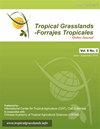Chemical composition, fermentation profile, microbial population and dry matter recovery of silages from mixtures of palisade grass and forage peanut
IF 0.7
4区 农林科学
Q3 AGRICULTURE, DAIRY & ANIMAL SCIENCE
引用次数: 4
Abstract
The study evaluated chemical composition, fermentation profile, microbial population and dry matter recovery of silages made from mixtures of palisade grass (Urochloa brizantha cv. Marandu) and forage peanut (Arachis pintoi cv. Belmonte). The experiment was conducted and analyzed in a complete randomized factorial design using 5 levels of each forage (0, 25, 50, 75 and 100% on a fresh matter basis), with and without microbial inoculant and 3 replications. The crude protein concentration increased linearly (P<0.05) and fiber concentration decreased linearly (P<0.05) as forage peanut level in silage increased. There was a positive quadratic effect (without inoculant) and positive linear effect (with inoculant) on lactic acid concentration (P<0.05) and a positive quadratic effect (P<0.05) on lactic acid bacteria population with increasing forage peanut levels in silage. The main effects of the addition of forage peanut to palisade grass at ensiling were improvement in the chemical composition and fermentation profile of the grass silage. We recommend adding 25–75% forage peanut to palisade grass prior to ensiling to improve the quality of the resulting silage but there is little merit in adding microbial inoculant to the forage at ensiling. Feeding studies with animals would verify potential benefits in production from inclusion of legume with grass at ensiling, while studies with addition of energy sources at ensiling would determine any further benefits to be achieved in silage quality.栅栏草与饲草花生混合青贮的化学成分、发酵特征、微生物种群和干物质回收率
研究了栅栏草(Urochloa brizantha cv.)混合青贮的化学成分、发酵特征、微生物数量和干物质回收率。和饲料花生(arachhis pintoi cv。Belmonte)。试验采用完全随机因子设计,每种饲料添加5个水平(0、25、50、75%和100%),添加和不添加微生物接种剂,重复3次。随着青贮花生饲粮水平的升高,粗蛋白质浓度线性升高(P<0.05),纤维浓度线性降低(P<0.05)。随着青贮花生饲粮添加量的增加,乳酸菌数量呈正二次效应(P<0.05)和正线性效应(P<0.05),且呈正二次效应(P<0.05)。青贮期篱笆草中添加花生饲料的主要效果是改善了青贮草的化学成分和发酵特性。建议在青贮前在栅栏草中添加25-75%的饲料花生,以提高青贮质量,但在青贮时在饲料中添加微生物接种剂的效果不大。动物饲养研究将验证在青贮过程中添加豆科植物和草对生产的潜在好处,而在青贮过程中添加能源的研究将确定在青贮质量方面取得的任何进一步好处。
本文章由计算机程序翻译,如有差异,请以英文原文为准。
求助全文
约1分钟内获得全文
求助全文
来源期刊

Tropical Grasslands-Forrajes Tropicales
Agricultural and Biological Sciences-Agronomy and Crop Science
CiteScore
1.60
自引率
0.00%
发文量
36
审稿时长
16 weeks
期刊介绍:
The Journal publishes, in English or Spanish, Research Papers and Short Communications on research and development, as well as contributions from practitioners (Farmer Contributions) and Review Articles, related to pastures and forages in the tropics and subtropics. There is no regional focus; the information published should be of interest to a wide readership, encomprising researchers, academics, students, technicians, development workers and farmers.
In general, the focus of the Journal is more on sown (''improved'') pastures and forages than on rangeland-specific aspects of natural grasslands, but exceptions are possible (e.g. when a submission is relevant for a particularly broad readership in the pasture and forage science community).
The Journal will also consider the occasional publication of associated, but closely related, research in the form of an additional scientific communication platform [e.g. a re-make of the former Genetic Resources Communication series of the former Division of Tropical Crops and Pastures of the Commonwealth Scientific and Industrial Research Organisation (CSIRO), Australia].
Areas of particular interest to the Journal are:
Forage Genetic Resources and Livestock Production[...]
Environmental Functions of Forages[...]
Socio-economic Aspects[...]
Topics within the aforementioned areas may include: Diversity evaluation; Agronomy; Establishment (including fertilization); Management and utilization; Animal production; Nutritive value; Biotic stresses (pests and diseases, weeds); Abiotic stresses (soil fertility, water, temperature); Genetics and breeding; Biogeography and germplasm collections; Seed production; Ecology; Physiology; Rhizobiology (including BNF, BNI, mycorrhizae); Forage conservation; Economics; Multilocational experimentation; Modelling.
 求助内容:
求助内容: 应助结果提醒方式:
应助结果提醒方式:


